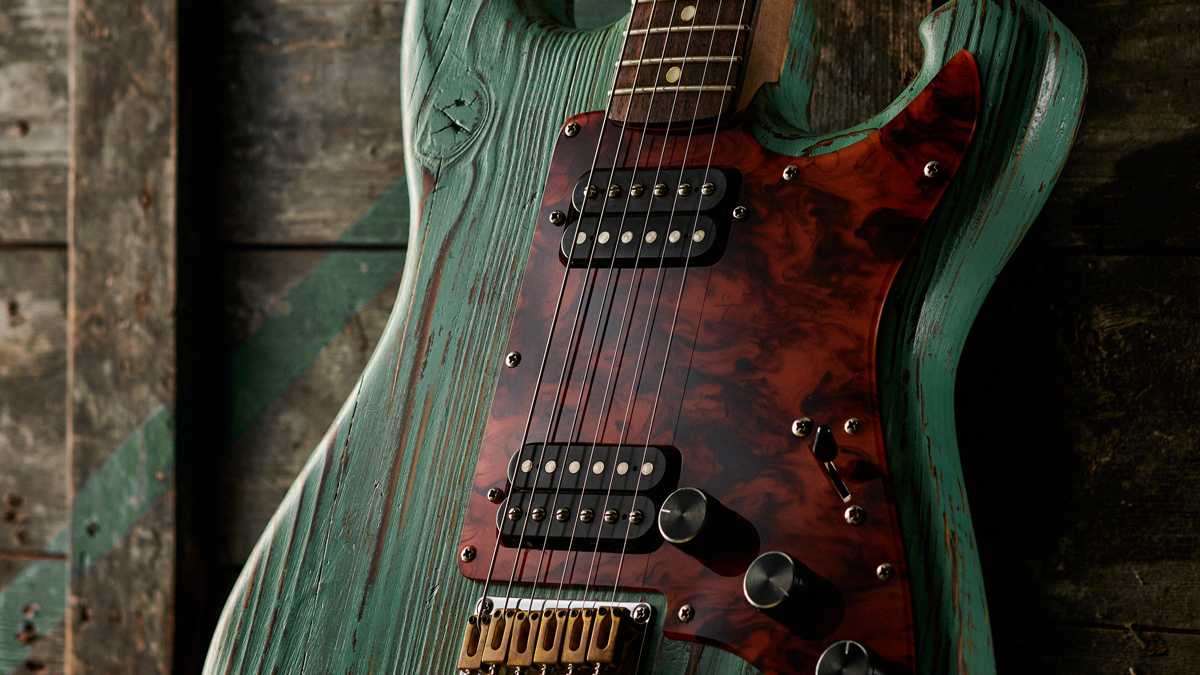Guitar World Verdict
This remarkable reclaimed instrument’s resonant, thumping rock voice and great playability seal the deal. We’ve played guitars three times the price that haven’t delivered either so well.
Pros
- +
Great repurposing concept.
- +
Excellent neck work, setup and playability.
- +
Strong voicing from the secondhand pickups.
- +
Boutique vibe without the price.
Cons
- -
The body prep and rustic finish won’t suit every player.
You can trust Guitar World
Earlier this year, we were pleasantly impressed by Maybury’s Cholla, a unique slice of original British-made craft and powered by a set of superb Sunbear pickups, also UK-made.
Maybury is the name chosen by sole luthier Jason Snelling for his small range of electric guitars, but aside from these, his start-up models are coined Upscalers. The concept is simple: by using reclaimed wood for the body, pre-loved necks and parts, Jason can offer a handmade UK build at a much lower price point than his standard models.
As you can see, the Fish Hook S is loosely based on the Stratocaster, those hooked horns and slightly offset waist adding plenty of originality. But it’s the rustic-looking teal chalk-paint finish over a vividly grained spruce body (floor joists from a 1930s house that was being renovated) that’s the immediate talking point.
It’s a 44mm thick two-piece body, though that’s not immediately obvious thanks to quite a few splits and nail holes, not to mention the far from flat grain ridges. Fans of pristinely joined, planed and smooth woodwork, please look away.
Expecting to be told that the neck is made from a reclaimed fence post, we’re a little surprised to learn it’s actually from a cheapo 2006 Squier Affinity that has been stripped and refinished.
But, somehow, Jason has transformed the ordinary into the exceptional: it has a reshaped and slightly hooked headstock shape, the ‘bare wood’ feel is actually oil-and-wax finished, while the rosewood fingerboard is a vibrant red-ish brown and peppered with Jason’s hallmark brass-ringed resin inlays.
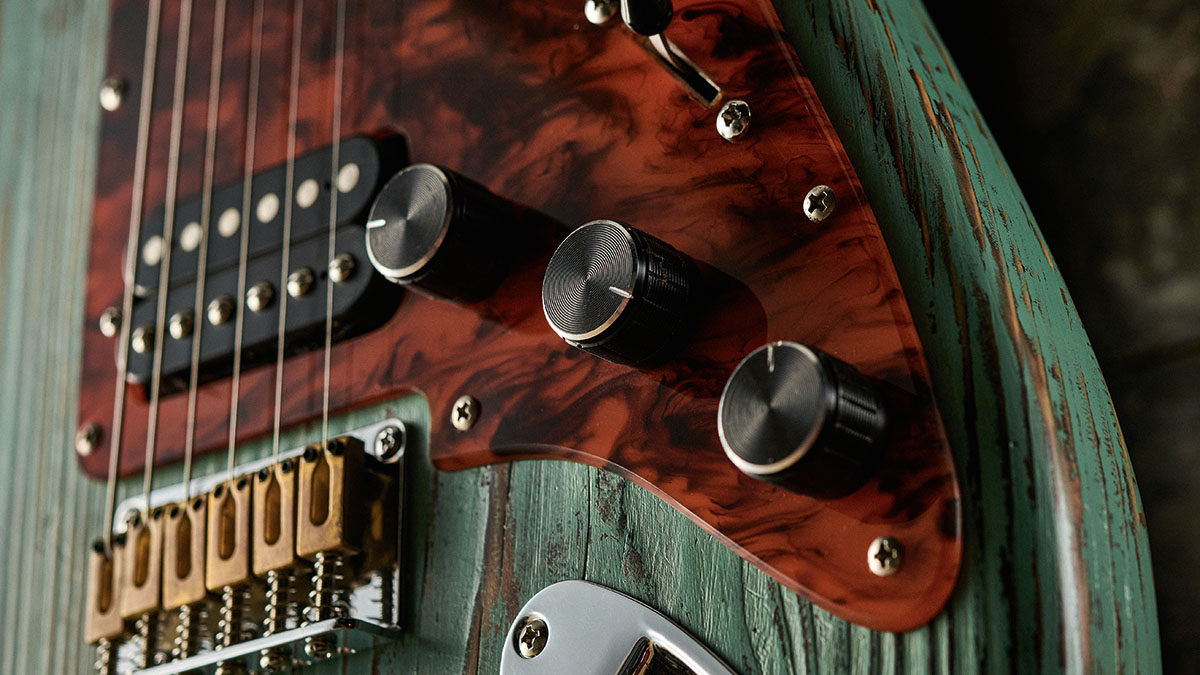
But it’s not all hand-me-downs. That vibrantly coloured scratchplate, for example, is a “translucent acrylic amber tortoiseshell that I made from an off-cut I had from a previous build”, Jason tells us, and to our eye it’s the element that ties the design together.
Aside from a (thankfully) new control circuit, the tuners are a generic die-cast style, while Jason admits he has no idea of the origin of the simple bridge.
The baseplate is chromed steel and the block brass saddles are perfectly good; as supplied, it’s through-strung but could be top-loaded, too. Oh, and the cupped jack plate is from a Mexican-made Fender, while those funky control knobs are from an old record player.
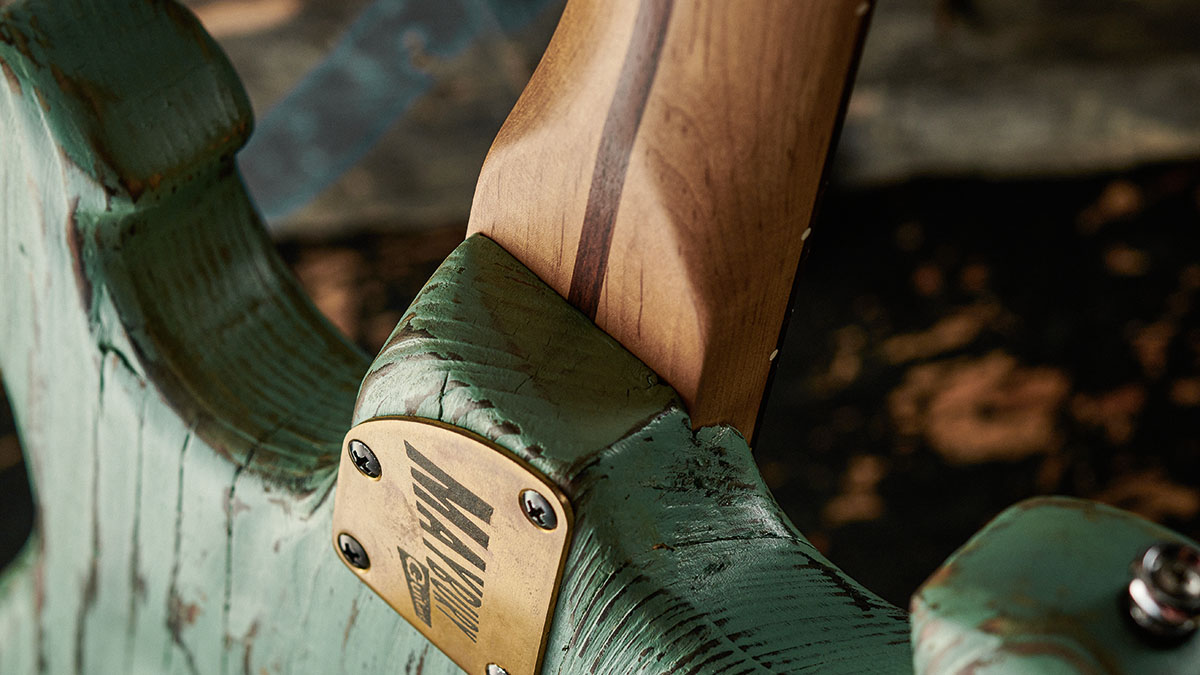
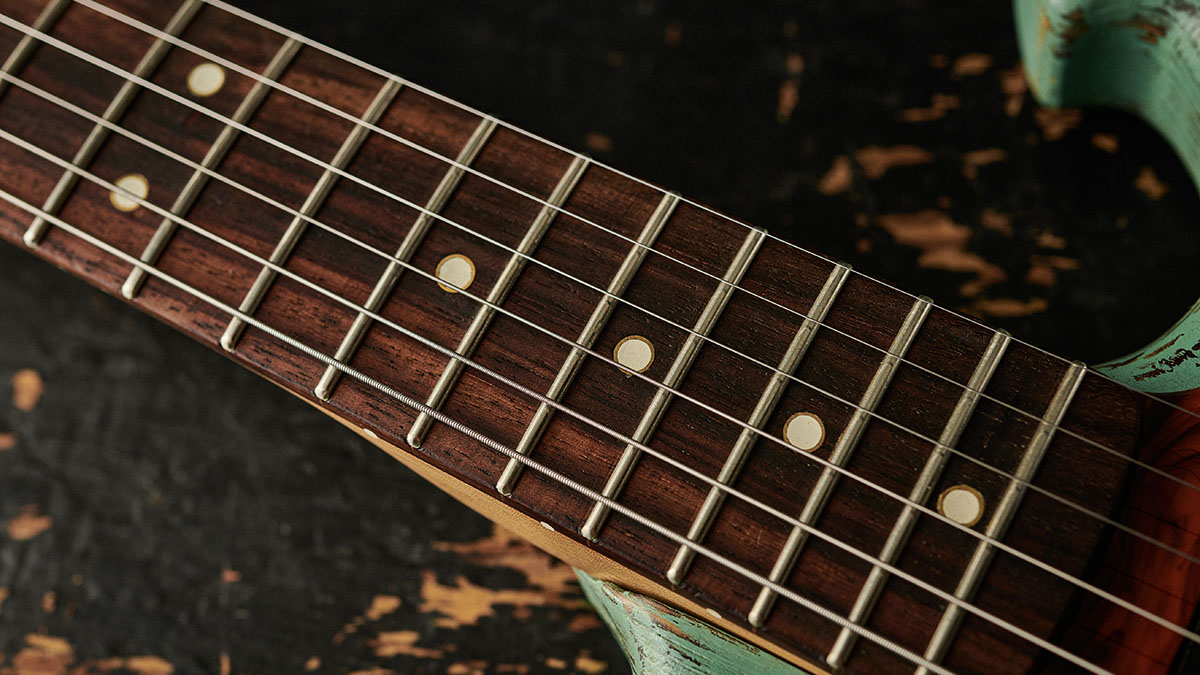
Feel & Sounds
While the guitar isn’t featherweight like an increasing number of UK builds we’re seeing, at 3.37kg (7.4lb) it’s perfectly good for the style, and although the neck might have humble origins it doesn’t feel it.
Yes, it’s slim, 41.56mm at the nut, but the string spacing is regular at 35mm and in depth the nicely shaped C profile is pretty mainstream, just under 21mm at the 1st fret filling out to 22.4mm by the 12th.
The frets are medium sized, around 2.41mm wide by 1.19mm high, the ends are nicely domed and the edges of the ’board are lightly rolled and thumb-around friendly. Irrespective of the origin, it’s good craft and set up well, too.
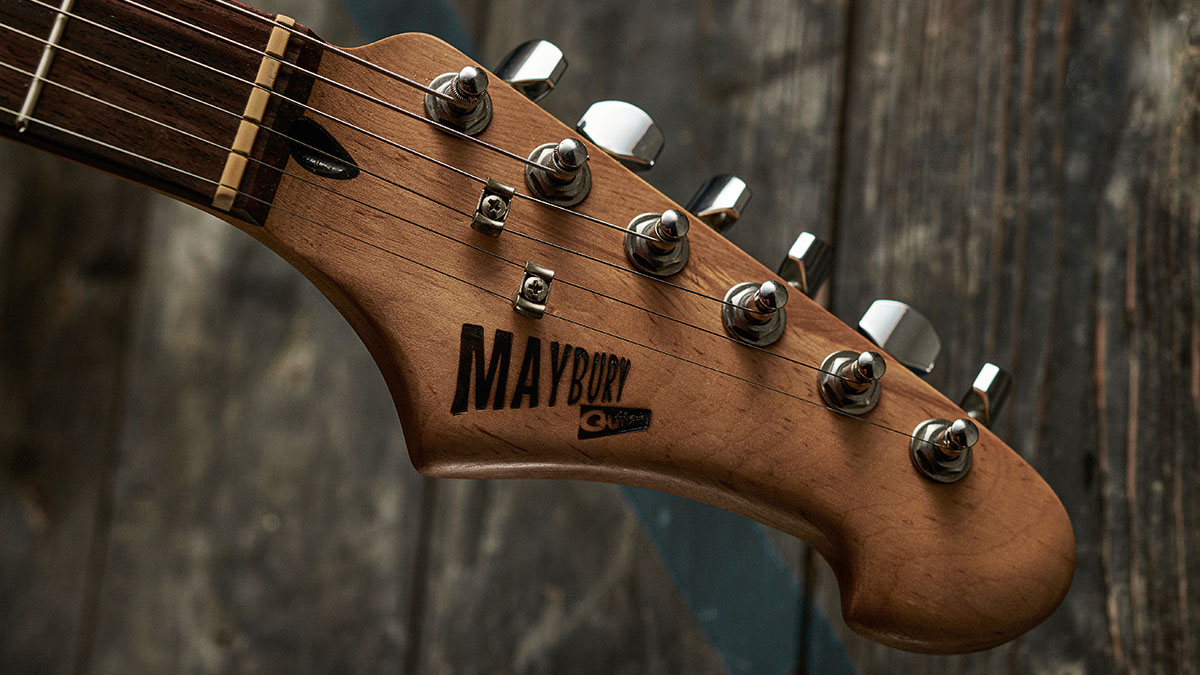
If you like your HH ‘SuperStrats’, you’re in for a treat, as you’re into resonant rock-ready territory at the bridge. There’s plenty of beef without overly nasal midrange, which is countered by a big woody neck voice that’s clear without being over bright. Cranked, it does woody Les Paul and there’s enough articulation for big-bodied cleans.
The mix perhaps isn’t as clear and detailed as it might be with lower powered humbuckers, but we’re not complaining. Here are three very strong, lively and resonant sounds, while the volume control has a great taper if you just want to pull it back and clean things up a little. It’s a joy to play with sounds to match.
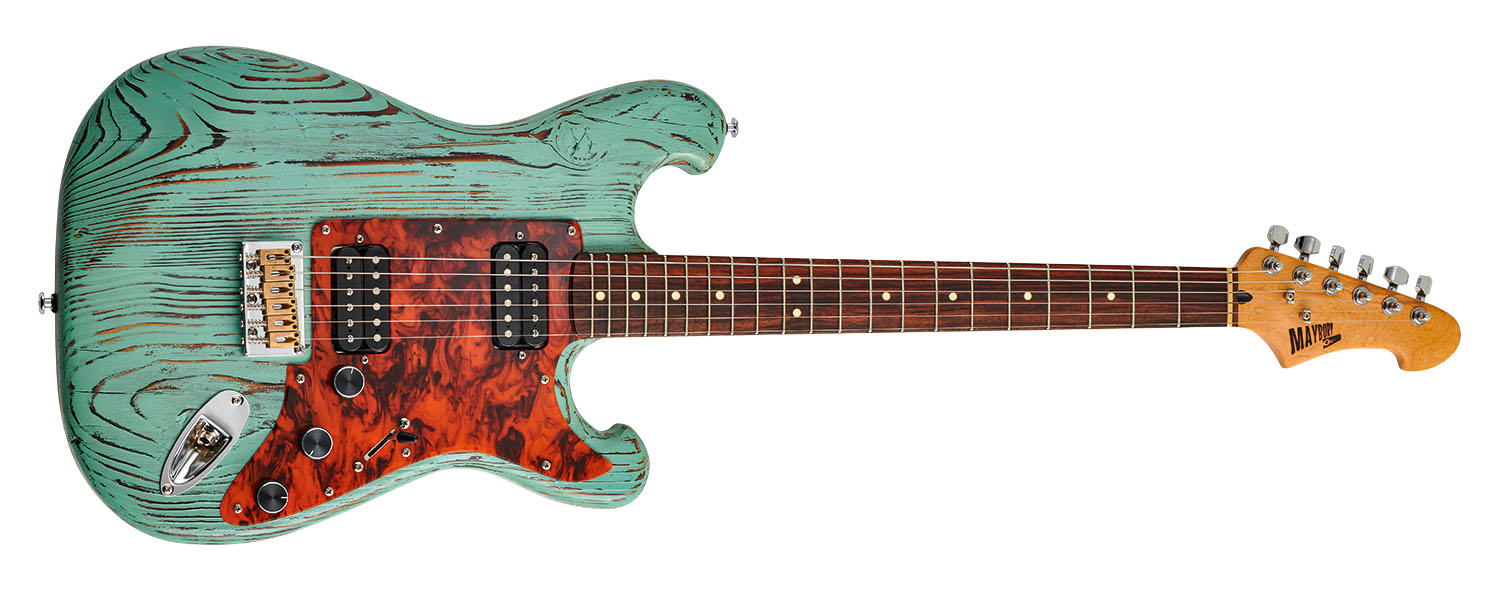
Verdict
Just a few months ago, this guitar was a disparate collection of unwanted parts and leftovers from a house in need of renovation. Quite how Jason Snelling has turned this motley selection into such a vibey, great-playing and juicy-sounding musical instrument might veer on alchemy.
Now, not everyone will get the shape of this guitar, nor its rustic makeover finish, but – to this writer, at least – they just add to the uniqueness of the build. It’s simply the resonant, thumping rock voice and great playability that seal the deal. We’ve played guitars three times the price that haven’t delivered either so well. On this evidence, Jason might become an even busier man!
Specs
- PRICE: £950 (inc gigbag)
- ORIGIN: UK
- TYPE: Double-cutaway electric bolt-on
- BODY: Reclaimed spruce
- neck: Maple, bolt-on
- SCALE LENGTH: 648mm (25.5”)
- NUT/WIDTH: Bone/41.6mm
- FINGERBOARD: Rosewood, brass and resin inlays, 241mm (9.5”) radius
- FRETS: 22, medium
- HARDWARE: Through-strung hardtail bridge with 6x brass block saddles, enclosed tuners – chrome-plated
- STRING SPACING, BRIDGE: 52.5mm
- ELECTRICS: Ibanez uncovered humbuckers, 3-way lever pickup selector switch, master volume, tone 1 (neck), tone 2 (bridge)
- WEIGHT (kg/lb): 3.37/7.4
- OPTIONS: Aside from the body shape, typically recycled spruce, everything can be custom ordered or, of course, you can provide your own recycled – or new – parts
- RANGE OPTIONS: Outside of the Upscaler guitars, Maybury’s standard models include the Cholla, Fish Hook T and S, and the Saguaro double-cutaway that will typically cost £2,200‑£2,500
- LEFT-HANDERS: Yes
- FINISHES: Teal (as reviewed) from an extensive range of chalk paint finishes. Other finishes include burnt raw shou sugi ban and dyed shou sugi ban – oil/wax finished neck
- CONTACT: Maybury Guitars

Dave Burrluck is one of the world’s most experienced guitar journalists, who started writing back in the '80s for International Musician and Recording World, co-founded The Guitar Magazine and has been the Gear Reviews Editor of Guitarist magazine for the past two decades. Along the way, Dave has been the sole author of The PRS Guitar Book and The Player's Guide to Guitar Maintenance as well as contributing to numerous other books on the electric guitar. Dave is an active gigging and recording musician and still finds time to make, repair and mod guitars, not least for Guitarist’s The Mod Squad.
“It holds its own purely as a playable guitar. It’s really cool for the traveling musician – you can bring it on a flight and it fits beneath the seat”: Why Steve Stevens put his name to a foldable guitar
“Finely tuned instruments with effortless playability and one of the best vibratos there is”: PRS Standard 24 Satin and S2 Standard 24 Satin review
